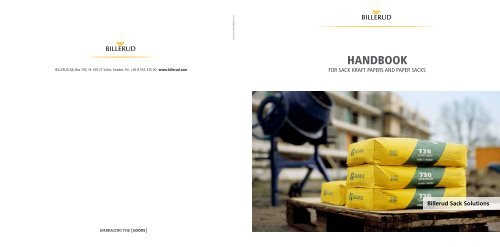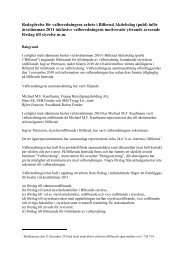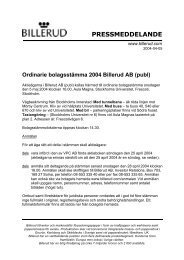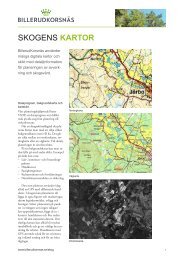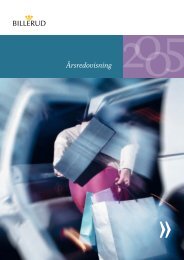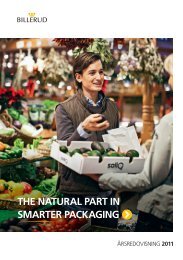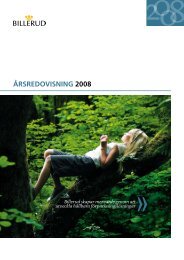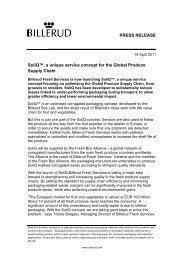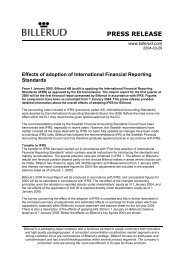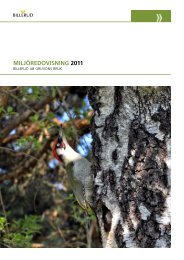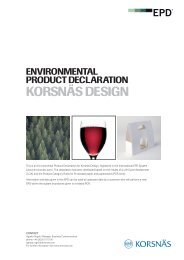Sack handbook - Billerud AB
Sack handbook - Billerud AB
Sack handbook - Billerud AB
- No tags were found...
Create successful ePaper yourself
Turn your PDF publications into a flip-book with our unique Google optimized e-Paper software.
04-2012/11642 Widén & Co<br />
<strong>Billerud</strong> <strong>AB</strong>, Box 703, SE-169 27 Solna, Sweden. Tel. +46 8 553 335 00 www.billerud.com<br />
Handbook<br />
for <strong>Sack</strong> Kraft Papers and Paper <strong>Sack</strong>s<br />
<strong>Billerud</strong> <strong>Sack</strong> Solutions
The purpose of this Handbook is to provide a set of useful information for<br />
people dealing with sack kraft paper, as well as for producers and end users of paper sacks.
table of CONTENT<br />
<strong>Sack</strong> Solutions 5<br />
Paper properties and testing methods 8<br />
Moisture influence 14<br />
Wrapping and storage 15<br />
Paper sacks strength 18<br />
Calculations for paper sacks 20<br />
Porosity for valve sacks 22<br />
Printability and appearance 24<br />
Norms for paper sacks 32<br />
Regulations to consider 34<br />
Drop tests 38<br />
Filling tests 39<br />
Friction and palletising 40<br />
Storage conditions for paper sacks 41<br />
Conversion factors 42<br />
Standard testing methods 43<br />
Valve sacks 28<br />
Open mouth sacks 30<br />
3
<strong>Sack</strong> solutions<br />
<strong>Billerud</strong> makes the best sack paper in the world. But that is no reason<br />
for taking it easy. We want more. Through the years we have gained solid<br />
experience and considerable know-how when it comes to the value chain<br />
for sacks. This gives us the strength to both identify and solve problems<br />
with existing sacks and to develop new and innovative solutions. And now<br />
we have gathered everything under one roof – <strong>Billerud</strong> <strong>Sack</strong> Solutions.<br />
Technical Services<br />
<strong>Billerud</strong> QuickFill ®<br />
Total Customer Value<br />
Training & Seminars<br />
www.billerud.com/sacksolutions sacksolutions@billerud.com<br />
5
sack kraft paper<br />
Scandinavian sack kraft paper is the strongest paper known to man.<br />
The main reason is the high quality raw material, with fibres from trees,<br />
which have grown very slowly due to the harsh Scandinavian climate.<br />
This makes the fibres extremely long and strong.<br />
7
Paper properties and testing methods<br />
Paper properties are measured in the<br />
machine direction (MD) and in the cross<br />
direction (CD), since there are significant<br />
differences in the properties, depending<br />
on the orientated fibre flow out of the<br />
headbox on the paper machine.<br />
If the index of a certain property is needed, it should<br />
be calculated by dividing the actual value with the<br />
grammage for the paper in question. Please observe<br />
that the units of the property then might change.<br />
Paper Testing Climate (ISO 187)<br />
The paper sample must be conditioned in the standard<br />
climate to reach equilibrium moisture before testing.<br />
Standard climate for paper testing is 50% RH (relative<br />
humidity) and 23 °C. The reason for conditioning is<br />
that the paper properties are strongly dependent of the<br />
paper moisture.<br />
Tensile Strength, kN/m (ISO 1924/3)<br />
The tensile strength is the maximum force that the<br />
paper will withstand before breaking. In the test a<br />
stripe of 15 mm width and 100 mm length is used<br />
with a constant rate of elongation. The tensile strength<br />
is one parameter in the measurement of the TEA,<br />
the most important sack paper property. In the same<br />
test the tensile strength, the stretch and the TEA value<br />
are obtained.<br />
Wet Tensile Strength MD,<br />
”wet strength”, kN/m (ISO 3781)<br />
After the test piece has been saturated, the tensile<br />
strength is tested in the same way as for a dry paper.<br />
For sack paper the test method is used for paper with<br />
wet strength resin added. Before testing it must be<br />
made sure that the wet strength has fully developed<br />
(depending on time and temperature). The relative wet<br />
strength is the relation between the wet tensile strength<br />
(MD) and the dry tensile strength MD. The wet strength<br />
is important e.g. for root crop sacks and refuse sacks.<br />
Grammage, g/m 2 (ISO 536)<br />
The grammage, basis weight, is measured by<br />
weight and surface area. In on-line measurement<br />
the grammage is measured by beta radiation.<br />
8
Tensile Energy Absorption (TEA),<br />
J/m 2 (ISO 1924/3)<br />
TEA is the main paper property for calculating the<br />
strength of the paper sack wall. This is verified by<br />
the correlation between TEA and drop tests. By<br />
dropping a sack the filling goods will move when<br />
reaching the floor. This movement means a strain<br />
on the sack wall. To withstand this strain the TEA<br />
should be high, which means that a combination of<br />
high tensile strength and good stretch in the paper<br />
will then absorb the energy.<br />
Stretch, % (ISO 1924/3)<br />
For sack paper the stretch is an important property.<br />
The stretch is a measurement of the elongation of the<br />
paper extended to rupture. The stretch is very important<br />
for the TEA value.<br />
This diagram shows that<br />
TEA is the combination<br />
of tensile strength and<br />
stretch. The TEA is the<br />
coloured area under<br />
the curve.<br />
Tensile index MD Nm/g<br />
Tear Strength<br />
(Tearing Resistance), mN (ISO 1974)<br />
The tearing force is the force required continuing the<br />
tearing from an initial cut in a paper sheet. The tear<br />
strength is important for e.g. sewn sacks where the<br />
needle holes can be a source of an initial cut.<br />
MD<br />
Stretch %<br />
0 2 4 6<br />
10
Burst Strength, kPa (ISO 2758)<br />
The burst strength is a measurement of the maximum<br />
pressure, which is possible to apply on the paper in a<br />
right angle to the surface. A bulging circular elastic<br />
diaphragm applies the pressure.<br />
Cobb 60s, g/m 2 (ISO 535)<br />
The sizing of the paper is measured as a Cobb-value.<br />
This is the amount of water absorbed by the paper<br />
surface in a given time. Most common is Cobb 60<br />
where the time is 60 sec.<br />
Moisture Content, % (ISO 287)<br />
The moisture content is measured by weighing<br />
the sample before and after oven drying at 105 °C.<br />
The moisture content is dependent on the surrounding<br />
climate and influences most of the paper properties.<br />
The moisture content is measured on-line in the<br />
paper machine.<br />
Friction Coefficient, (no unit) (ISO 15359)<br />
The paper friction is important for good palletising<br />
properties of the filled sacks. However the friction<br />
is very much influenced by printing and general<br />
handling. The friction coefficient can be measured<br />
in many different ways, but the ISO standard method<br />
is recommended.<br />
11
Air Resistance Gurley, s (ISO 5636/5)<br />
The air resistance is a measurement of the time taken<br />
for 100 ml of air to pass through a specified area of the<br />
paper sheet. Short time means a highly porous paper,<br />
notice that this can be described as high air permeance<br />
as well as low air resistance. For valve sacks with<br />
powdered goods a highly porous paper gives higher<br />
filling speed, smaller sack volume and a cleaner<br />
filling process.<br />
Surface Roughness<br />
(Bendtsen, PPS, Sheffield, Bekk, etc.)<br />
The surface roughness will very much affect printing,<br />
lamination and other demanding surface treatments.<br />
However, roughness has no direct relation to friction.<br />
Gloss, %<br />
The gloss is the paper ability to reflect the incoming<br />
light in a specified angle. The paper gloss increases<br />
by claycoating and calendering of the surface.<br />
Opacity, % (ISO 2471)<br />
A high opacity is important for the appearance of the<br />
packaging, so that an underlying brown paper or the<br />
content of the bag is not to be visible.<br />
In addition to the above tests your supplier can measure<br />
many other properties that are essential for specific<br />
applications. On pages 44-46 are the most important<br />
testing methods and conversion factors listed.<br />
Brightness, % (ISO 2470)<br />
High brightness gives a good general appearance to<br />
printing. The brightness is the amount of the incoming<br />
light that will be reflected by the paper surface. The<br />
measurement is made with blue light, wavelength 457 nm.<br />
12
Moisture influence<br />
Relative strength %<br />
140<br />
130<br />
120<br />
110<br />
100<br />
90<br />
80<br />
70<br />
60<br />
RH in the air (%)<br />
Moisture content<br />
in paper, (%)<br />
Stretch<br />
TEA<br />
Tensile<br />
0 10 20 30 40 50 60 70 80 90 100<br />
6 7 7.5 9 10 12 13<br />
Paper is a hydrophilic material. This means<br />
that the moisture in the surrounding air<br />
influences the paper properties.<br />
In a climate with high relative humidity the paper will<br />
have higher moisture content and opposite in a drier<br />
climate. Therefore all paper testing should take place<br />
in a standardised climate of 50% RH and 23 °C.<br />
The variations of TEA, tensile strength and stretch<br />
with relative humidity in the air, are shown in the figure.<br />
Stretch increases with high moisture, tensile strength<br />
decreases. TEA has an optimum at 7-10% moisture<br />
contents in the paper, corresponding to 40-70%<br />
relative humidity. But also at very low paper moisture,<br />
for example after filling with hot cement of<br />
90-100 °C, still a major part of the TEA is left.<br />
14
Wrapping and storage<br />
The reason for wrapping the reels carefully is to<br />
avoid damage or contamination during handling.<br />
Additionally a PE-coated wrapping keeps the<br />
moisture content of the material at a stable level,<br />
this is important for good runability at the sack<br />
producer and end user.<br />
An optimised stock level should be held to ensure a fluent<br />
operation at the sack converter with regard to raw material<br />
demand as well as to delivery fluctuations.<br />
Basic Rules<br />
Keep the reel wrapping in place on the reels as long as possible.<br />
Allow 24 hours storage time for the reels in machine/<br />
printing room for conditioning, with the wrapping on.<br />
Use a well-ventilated warehouse with preferably<br />
a temperature of 0-25 °C.<br />
Avoid extreme atmosphere and temperature variations.<br />
Handle stored materials with care.<br />
Store reels on the end, and arrange reels so that<br />
their labels are clearly visible.<br />
Keep cleanness and order in the warehouse with<br />
good access to the stored material.<br />
Use clamp trucks for reel handling.<br />
Train the personnel in handling techniques.<br />
15
Paper sacks<br />
The fact that the paper quality is most important for the sack quality and<br />
the cost efficiency in the distribution system, is well known world-wide.<br />
The development of high quality extensible papers, with excellent cross<br />
direction properties, has made a major contribution in that respect.<br />
17
Paper sacks strength<br />
For filling and handling systems in general we recommend<br />
balanced TEA-values according to the following table.<br />
Handling conditions<br />
Normal<br />
Tough<br />
Balanced TEA<br />
330-390 400-450<br />
J/m 2<br />
for 25 kg - sack<br />
Balanced TEA<br />
for 50 kg - sack<br />
J/m 2 430-490 500-550<br />
Balanced TEA-values may be calculated from the machine and<br />
cross direction values by use of the following formulas.<br />
Geometrical TEA =<br />
(TEA MD x TEA CD)<br />
Balanced TEA could also be calculated as:<br />
0.43 TEA MD + 0.57 TEA CD For a 4-ply sack<br />
0.37 TEA MD + 0.63 TEA CD For a 3-ply sack<br />
0.31 TEA MD + 0.69 TEA CD For a 2-ply sack<br />
0.27 TEA MD + 0.73 TEA CD For a 1-ply sack<br />
These formulas are used for paper<br />
qualities where TEA CD shows lower<br />
value than TEA MD.<br />
18
600<br />
550<br />
500<br />
450<br />
400<br />
350<br />
300<br />
The importance of TEA for the<br />
sack construction. Nonperforated sacks<br />
TEA demand on the sack, J/m 2<br />
3x80<br />
3x70<br />
250<br />
2,0 2,1 2,2 2,3 2,4 2,5 2,6 2,7 2,8 2,9 3,0 3,1 3,2 3,3 3,4 3,5 3,6 3,7 3,8 3,9 4,0 4,1 4,2 4,3<br />
TEA-index balanced, J/g.<br />
2x90<br />
2x80<br />
2x70<br />
1x120<br />
1x110<br />
Number of plies<br />
and grammage, g/m 2<br />
From the diagram we can see the following:<br />
To reach 400 J/m² when a low quality<br />
paper is used with a balanced TEA-index<br />
of 2.25 J/g, the sack must be made of 2-ply<br />
of 90 g/m² each.<br />
High quality paper, with a balanced TEAindex<br />
of 2.9 J/g, makes it possible to use<br />
2 ply of 70 g/m²-paper for the same total<br />
sack strength.<br />
A single-ply sack, for 25 kg goods, can be<br />
made of a 110 g/m 2 paper with a TEA-index<br />
of 3.65 J/g. The TEA-value will then be 400 J/m 2 .<br />
Today <strong>Billerud</strong> deliver sack paper grades with very<br />
high balanced TEA index. This means there are great<br />
possibilities to reduce packaging material by use of<br />
<strong>Billerud</strong> papers.<br />
19
Calculations for paper sacks<br />
The sack strength and material reduction will be best calculated with the <strong>Billerud</strong> <strong>Sack</strong><br />
Calculation Tool, a programme suitable for most computers and available for <strong>Billerud</strong> customers.<br />
Paper Quality<br />
Total TEA<br />
needed<br />
in the sack<br />
Balanced<br />
TEA index of<br />
paper<br />
Total<br />
grammage<br />
in sack<br />
Grammage<br />
of each ply<br />
Weight of<br />
each sack<br />
2- ply 3- ply at 1 m 2<br />
sack surface<br />
Material<br />
reduction<br />
Amount<br />
of paper<br />
needed<br />
for 1<br />
million<br />
sacks<br />
J/m 2 J/g g/m 2 g/m 2 g/m 2 g % tonnes<br />
Supplier 1,<br />
unperforated sacks<br />
450 2.15 210 70 210 0 210<br />
Supplier 1,<br />
450 1.88 240 80 240 -14 240<br />
perforated sacks *)<br />
Brown QuickFill SE 450 3.25 140 70 140 33 140<br />
*) The perforation reduces the TEA-index by 13% in this example.<br />
20
The reduction of packaging material also brings<br />
the following advantages:<br />
Less transport costs for the reels.<br />
Less paper per sack – better profitability.<br />
Less paper in stock per million sacks<br />
produced (less capital in store).<br />
Fewer reel changes in the tuber.<br />
More sacks per pallet – less transport costs.<br />
Faster filling thanks to better total porosity.<br />
Better tear strength of each ply – if fewer<br />
layers but higher grammage is used.<br />
<strong>Billerud</strong> sack paper is among the strongest paper in the world.<br />
The main reason is a high-quality fibre raw material from trees<br />
which have grown slowly in a harch Scandinavian climate.<br />
21
Porosity for valve sacks<br />
The ability of sack paper to allow air to<br />
pass is often specified as Gurley value in<br />
seconds. Following the increased demand<br />
of high filling speeds, the demand for<br />
porous papers has increased, i.e. a<br />
decrease of the Gurley levels from 20 sec.<br />
to 3 sec. over the last 20 years. <strong>Billerud</strong><br />
QuickFill papers have 3-5 sec. Gurley.<br />
<strong>Sack</strong>s filled with powdered materials<br />
like cement, gypsum, clays, fine-grained<br />
sugar, etc, require a paper with very<br />
good porosity.<br />
Advantages of High Porosity Paper<br />
The sack will be exposed to less strain during filling,<br />
therefore a lower sack breakage could be expected.<br />
The air escapes quicker from the filled sacks and<br />
therefore the size of the sack can be reduced;<br />
experience shows that a reduction of 4-10% is<br />
possible. Perforation of the sack is no longer necessary,<br />
which then reduces dusting at filling and gives a better<br />
environment and cleaner sacks. Perforation of the sack<br />
reduces the TEA value by at least 10-20%.<br />
Production of porous paper<br />
Normally the strength of a paper is increased by<br />
refining of the fibres. The disadvantage of traditional<br />
refining (low consistency) is that this also makes the<br />
paper less porous. High consistency refining develops<br />
the stretch of the paper without reducing the porosity<br />
to any appreciable extent. The latest development is the<br />
production of highly porous papers in combination<br />
with very high strength values.<br />
Free-film and porous papers<br />
When a free-film, perforated or slitted, is incorporated<br />
in the sack construction, the total porosity of the sack<br />
will be reduced. In such cases it seems unnecessary<br />
to use highly porous papers. That is however not true.<br />
Extensive studies show that a combination of free-film<br />
and porous papers give an acceptable permeability<br />
of the sack, especially when the film has a rather<br />
open area.<br />
The water vapour transmission rate (WVTR) increases<br />
with the open area of the film. Therefore it will be a<br />
compromise between sack permeability and WVTR<br />
value. A very high porosity of the paper, and a somewhat<br />
less open free-film, may result in a sack with sufficient<br />
porosity, but still acceptable protection from moisture.<br />
22
Printability and appearance<br />
Most paper sacks are printed on the<br />
outer ply. The main reason for printing<br />
industrial sacks is to identify the content,<br />
but there is an increasing demand for<br />
more information and improved appearance.<br />
For consumer sacks a high quality<br />
finish is an important commercial factor.<br />
The dominant printing method in the sack industry is<br />
flexography. For simple 1-3 colour prints, sack paper<br />
may be printed in-line in the tubers, or more often<br />
nowadays, in separate pre-printers. Print quality as<br />
well as productivity is improved with pre-printing.<br />
The print quality depends on the right combination<br />
of the artwork, printing press, plates, anilox rollers,<br />
colours and paper surface. The skill of the printing<br />
operators is of course also very important. Most<br />
industrial sacks are printed in 1-4 colours. For more<br />
demanding applications, such as consumer sacks,<br />
process pre-printing is mostly used.<br />
Flexographic Printing Machines<br />
Flexography is the fastest growing printing method.<br />
For modern flexo presses the technology, efficiency<br />
and capacity is very much improved. For process printing<br />
the anilox rollers, colour application system, web<br />
video control, and the cleaning and drying system are<br />
all very important. New presses may be equipped with<br />
8-10 colour stations. Older flexo presses can still give<br />
good print quality if the machines are well maintained<br />
and the anilox rollers regularly changed.<br />
24
Printing Inks<br />
Most flexo printers use water based inks. In-house<br />
colour blending systems and viscosity control are<br />
useful tools. Where friction properties are critical,<br />
it will help to reduce the area covered by ink, and<br />
to modify the ink composition.<br />
process colours; cyan, magenta and yellow, a fourcolour<br />
process picture can be printed. For more<br />
demanding process printing, then calendered or<br />
clay-coated paper grades should be selected due to<br />
the optimised surface properties.<br />
Printing Plates<br />
Photopolymer plates have gradually replaced rubber<br />
plates. For high quality process printing the trend is to<br />
reduce the plate thickness. The plate manufacturers<br />
have materials with different hardness. For rough<br />
substrates a softer plate gives improved print quality.<br />
Paper Grades<br />
<strong>Billerud</strong> has a wide range of sack kraft papers for<br />
various sack constructions as well as printing<br />
demands. For good printing results the paper grade<br />
selected should have the right appearance, formation,<br />
opacity and a generally suitable print surface.<br />
Also brown sack paper gives a good print quality but<br />
when lighter colours, half tone printing and improved<br />
total appearance is required, white sack papers are<br />
recommended. The paper surface represents the white<br />
colour and together with the black and the three<br />
25
Types of sacks<br />
There are two principal types of paper sacks, open mouth sacks<br />
and valve sacks. They may all be of one or more plies and may<br />
incorporate barrier plies for specific applications. The types may<br />
be summarised as follows.<br />
27
Valve sacks<br />
Valved Pasted<br />
Flat sacks from flush cut or stepped end tubes.<br />
The bottoms have a hexagonal shape. The flush cut<br />
tube is the simplest way to produce a sack with folded<br />
and pasted ends. The bottoms must be capped with a<br />
rectangular paper sheet to give them sufficient strength,<br />
to improve sift-proofing and to give a flat surface, which<br />
may be used for identification data, etc.<br />
When opening the sewing line the end user has easy<br />
access to the content.<br />
Valved Pasted<br />
and Sewn<br />
Valved Pasted<br />
Valved Sewn<br />
Flat or gusseted sack from flush cut tubes only.<br />
The valve is inserted by a manual operation.<br />
The shape of the filled sack is not as good as the<br />
pasted type.<br />
Valved Sewn<br />
Valved Pasted and Sewn<br />
Flat sacks generally from flush cut tubes. This type<br />
of sack allows for valve filling at one end and sewing,<br />
with easy opening, at the other end. A carrying handle<br />
may be incorporated into the sewing line, but this is<br />
not appropriate if the package exceeds 15 kg in weight.<br />
28
Single ply sacks<br />
The TEA-values of sack papers have been increased due to<br />
intensive development work during the years. The 2x70 g/m 2<br />
sack is now standard in many countries. A further reduction<br />
of grammage may however bring some disadvantages like<br />
unstable convertability in the sack production lines. An interesting<br />
alternative is then to make 1-ply sacks of 110 or 120 g/m 2 paper.<br />
<strong>Billerud</strong> has therefore developed suitable paper grades for this<br />
application; White and Brown QuickFill Single.<br />
Valve Designs<br />
The valves that may be incorporated into sacks are many and<br />
varied, they may be internal or external. Different types of<br />
material can be used, for example paper, PE, non-woven and<br />
textile. Special coatings are also in use to allow the valve to be<br />
heat-sealed using hot air, high frequency or ultra sonic. External<br />
valves may be provided with a thumbhole notch to make their<br />
opening easier. After filling external valves can be tucked by<br />
hand into the pocket formed by the fold. If necessary, some<br />
valves may be made narrower than the sack end.<br />
29
Open mouth sacks<br />
Open Mouth Sewn<br />
Flat or gusseted from a flush cut tube. This type of sack is<br />
easily filled using simple equipment. They are suitable for<br />
powdered, granular products, cereals and root crops.<br />
Open Mouth Sewn<br />
Open Mouth Pinch Closed<br />
Flat or gusseted from a stepped end tube. This type of sack may<br />
be used as an alternative to a sewn sack. It may be preferred<br />
where a hermetically sealed package is required. If necessary<br />
the open end can be sealed by reactivating a pre-applied coating<br />
of hotmelt adhesive. The inside ply, if polymer coated, can be<br />
heat sealed to prevent ingress of moisture. This type of sack is<br />
particularly useful for packaging hygroscopic materials.<br />
Open Mouth Pinch Closed<br />
(Roll bottom, single closed)<br />
30
Open Mouth Pasted Double Fold<br />
Flat or gusseted from a flush cut tube. This is a variation<br />
on the Pinch sack. This type of sack can be made<br />
with an “Easy Opening” closure whilst still giving a<br />
very good sift-proof closure.<br />
Open Mouth Pasted<br />
Double Fold<br />
These result in greater stability of the filled sacks on<br />
conveyors during top closure and also present a good<br />
flat area for the addition of extra identification data.<br />
Open mouth S.O.S.<br />
The sack is always gusseted. This sack is produced on<br />
a specific machine combining a tuber and a bottomer.<br />
The bottom has a rectangular shape. S.O.S. means<br />
Self-Opening Satchel.<br />
Open mouth S.O.S.<br />
Open Mouth Pasted<br />
From a flat tube only, generally flush cut. The bottom<br />
has a hexagonal shape, but when filled the sacks have<br />
rectangular bottoms.<br />
Open Mouth Pasted<br />
Top Closure of Open Mouth <strong>Sack</strong>s<br />
All open mouth sacks may have their tops closed by<br />
sewing. However pinch sacks are generally closed by<br />
reactivation of a pre-applied hotmelt adhesive and this<br />
requires the use of special equipment.<br />
31
Norms for paper sacks<br />
Measurement of empty sacks<br />
(EN 26591 –1)<br />
This norm specifies the method of measuring the<br />
dimensions of empty paper sacks. All dimensions are<br />
external and will be expressed in millimetres.<br />
Measurements will be made in the centre of the sack.<br />
Definitions and symbols:<br />
Length of sack (a): distance between the<br />
transverse edges of the flat sack.<br />
Width of sack (b): distance between the<br />
longitudinal edges of the flat sack.<br />
Width of gusset (e): distance between the<br />
external creases of the opened out gusset .<br />
Width of bottom (c): distance between the<br />
bottom edge folds.<br />
Width of the valve (v): internal dimension<br />
of the valve between the valve edge folds.<br />
b<br />
b<br />
b<br />
v<br />
c 1<br />
a<br />
a<br />
a<br />
c<br />
c 2<br />
e<br />
32
Valve Position (EN 26591-1)<br />
The following designation is applicable to both pasted<br />
and sewn valved sacks. With the longitudinal seam<br />
downward and displaced to the right of the sack,<br />
when viewed from above, the valve position shall<br />
be described as TOP or BOTTOM and as LEFT or<br />
RIGHT as shown in figure below<br />
Top left<br />
Bottom left<br />
Top right<br />
Longitudinal<br />
seam<br />
Bottom right<br />
<strong>Sack</strong> volume calculation<br />
(ISO Technical Report 8281/1)<br />
The ISO Committee has developed a formula giving<br />
the possibility to calculate the volume and the size of a<br />
filled sack by using the dimensions of the empty sack.<br />
The symbols of the empty sack dimensions are the<br />
same as those described in EN 26591-1.<br />
Volume calculation for valved pasted sacks.<br />
(V in litres, A, B, C in mm).<br />
V = b 2 (0.2668 a + 0.4047 c – 0.1399 b) x 10 –6<br />
Filled dimensions from flat dimensions (mm).<br />
A (length of filled sack)<br />
= 1.025 a + 1.02 c – 0.0028 c 2 – 80<br />
B (width of filled sack)<br />
= 0.920 b – 0.0015 c 2 – 35<br />
C (width of bottom of filled sack)<br />
= 0.095 b + 0.0025 c 2 + 58<br />
The choice of the filled sack dimensions is also<br />
dependent on the pallet pattern if sacks are palletised.<br />
The sack volume and other parameters could preferably<br />
be calculated with <strong>Billerud</strong>’s sack calculation tool, a<br />
programme suitable for most computers.<br />
Dimensional Tolerances for Paper <strong>Sack</strong>s<br />
(EN 28367-1)<br />
This norm specifies a set of tolerances applicable to the<br />
manufacture of paper sacks.<br />
33
Regulations to consider<br />
A wide range of products can be packed into paper<br />
sacks. These might then be transported world-wide<br />
by a number of different methods. It is necessary to<br />
be aware of any hazardous properties of products<br />
being packed and of any relevant National or<br />
International Regulations. The following list gives an<br />
indication of some bodies that produce regulations.<br />
United Nations: The recommendation on the<br />
Transport of Dangerous Goods. Commonly called<br />
the “Orange Book”.<br />
Forschungsgemeinschaft Kraftpapiere und<br />
Papiersäcke E.V. Germany.<br />
FDA, Food and Drug Administration, USA.<br />
BfR, Bundesinstitut für Risikobewertung, Germany.<br />
IATA, International Air Transport Association.<br />
ADR, European Agreement concerning the International<br />
Carriage of Dangerous Goods by Road.<br />
Pira International, UK.<br />
34
tests for sacks<br />
Drop testing of filled sacks until they break can be used to compare the<br />
relative strength of different sack constructions. This is normally made during<br />
the product development and when establishing a new sack specification.<br />
37
Drop tests<br />
Butt Drop Tests (EN 27965-1 or ISO 7965/1)<br />
Drop testing of filled sacks onto one end from a constant height,<br />
or regularly increasing height, will test the strength of component<br />
plies of a sack but will not test the strength of the end closures.<br />
The progressive drop height method will start from 0.3 m with<br />
an increment of 0.05 m after each drop.<br />
Flat Drop Tests (EN 27965-1 or ISO 7965/1)<br />
Drop testing of filled sacks onto the main faces from a constant<br />
height, or regularly increasing height, will test the strength of the<br />
end closures as well as of the component plies.<br />
The drops will be made alternatively on the front face and on<br />
the back face of the sack. The progressive height method will<br />
start from 0.85 m with an increment of 0.15 m after each drop.<br />
38 38
Filling tests<br />
<strong>Sack</strong> Porosity Test<br />
Porosity of manufactured valve sacks can be tested<br />
with special equipment by blowing air into the sack.<br />
The valved sack is mounted on an expanding spout,<br />
which ensures no leakage of air. Airflow is measured<br />
with rotameters at different pressure drops.<br />
Field Trials<br />
When paper sacks are being introduced into an<br />
entirely new market area, and particularly if multiple<br />
handling is involved, it is advisable to carry out<br />
at least a small initial field trial. Then all involved<br />
parties have the possibility to follow and evaluate<br />
the technical performance.<br />
39
Friction and palletising<br />
To get good stability of the pallets when<br />
transported a certain minimum level of<br />
friction is required. From the beginning<br />
paper normally has a good friction level,<br />
which however runs the risk of being<br />
reduced in the various production lines,<br />
mainly after printing and when filling<br />
materials act as lubricant between the sacks.<br />
General Information<br />
It is no longer difficult to measure friction as there is<br />
an approved ISO method (ISO 15359). The treatment<br />
of samples is however extremely critical, a fingerprint<br />
for example, reduces the friction considerably.<br />
The same goes for sheets rubbing against each other.<br />
Two main principles are being used when measuring<br />
friction on paper, namely the inclined plane and the<br />
horizontal test. The inclined plane can only measure<br />
the static friction, i.e. the power needed to start the<br />
sliding, whereas with the horizontal method you can<br />
also measure the dynamic friction, i.e. the continued<br />
sliding. Basic information about friction is given in<br />
a special brochure written by the research institute<br />
STFI-Packforsk, Sweden.<br />
Printing<br />
Printing inks containing waxes reduce friction considerably.<br />
If the friction is of vital importance the printed<br />
surfaces should be minimised and “friction inks”<br />
should be used; i.e. inks developed to give a minimum<br />
reduction of friction.<br />
Friction Increasing Agents<br />
When producing sacks, silicate solutions can be<br />
printed on the sack to improve friction properties.<br />
Disadvantages are costs and wear on manufacturing<br />
machinery, as some particles are also removed from<br />
the surface during the sack converting process.<br />
Stabilising of Pallets<br />
Various glues can be used when stacking sacks on<br />
pallets. The most frequently used is hotmelt, but<br />
spraying water can also improve the stability of pallets.<br />
Special sheets of paper covered with anti-slip agents<br />
can also be placed between the sack layers.<br />
Friction Paper<br />
Various types of patterns have been developed to<br />
improve the friction properties. The most prominent<br />
feature of friction paper is that they keep the higher<br />
friction properties longer if the sack surface becomes<br />
dusty. <strong>Billerud</strong> offer special grades with an embossed<br />
pattern in order to improve friction in dusty environment.<br />
40
Storage conditions for paper sacks<br />
The storage area for paper sacks should<br />
be a weatherproof covered building<br />
having good ventilation. <strong>Sack</strong>s should<br />
be stored raised off the ground to allow<br />
air to circulate beneath them.<br />
Storage areas should be free from contamination sources<br />
such as dust or corrosive vapours. Dusts may encourage<br />
mould growth and insect infestations, and corrosive<br />
vapours will damage the paper plies and reduce the<br />
strength of the sacks.<br />
When automatic sack applicators are used, the supplier<br />
will deliver sacks packed as flat as possible and put<br />
a frame on the top of each pallet. Ensure that sacks<br />
are maintained in good condition by careful stacking,<br />
especially of partly used units. Always store sacks so<br />
that they may be used in rotation according to when<br />
they were delivered (first in, first out).<br />
It is recommended that newly manufactured sacks<br />
should be allowed to stand for at least some days<br />
before use so that the moisture from water based<br />
adhesives can migrate evenly through the sacks.<br />
41
Conversion factors<br />
From US<br />
units<br />
Conversion<br />
factor<br />
To ISO<br />
units<br />
Grammage 1 lb/3000 ft 2 1.627 g/m 2<br />
Tensile strength 1 lb/inch 0.17513 kN/m<br />
1 kp/15 mm 0.65402 kN/m<br />
Tensile index 1 m 0.00980 Nm/g<br />
Stretch 1 % 1 %<br />
TEA 1 ft.lb/ft 2 14.60067 J/m 2<br />
1 lb-in/100in 2 1.75223 J/m 2<br />
1 kpm/m 2 9.81000 J/m 2<br />
TEA-index 1 kpm/kg 0.00981 J/g<br />
Tearing resistance 1 g 9.81000 mN<br />
Tear index 1 100 gm 2 /g 0.09810 mNm 2 /g<br />
Burst strength 1 kp/cm 2 98.10000 kPa<br />
1 lb/in 2 6.89500 kPa<br />
Air resistance Gurley 1 sec/100 ml 1 sec/100 ml<br />
Weight 1 Short Ton 907.2 kg<br />
From ISO<br />
units<br />
Conversion<br />
factor<br />
To US<br />
units<br />
Grammage 1 g/m 2 0.6146 lb/3000 ft 2<br />
Tensile strength 1 kN/m 5.710 lb/inch<br />
1 kN/m 1.529 kp/15 mm<br />
Tensile index 1 Nm/g 102 m<br />
Stretch 1 % 1 %<br />
TEA 1 J/m 2 0.0685 ft.lb/ft 2<br />
1 J/m 2 0.5707 lb-in/100in 2<br />
1 J/m 2 0.102 kpm/m 2<br />
TEA-index 1 J/g 102 kpm/kg<br />
Tearing resistance 1 mN 0.102 g<br />
Tear index 1 mNm 2 /g 10.2 100 gm 2 /g<br />
Burst strength 1 kPa 0.0102 kp/cm 2<br />
1 kPa 0.145 lb/in 2<br />
Air resistance Gurley 1 sec/100 ml 1 s<br />
Weight 1 Kg 2.2046 Lb<br />
42
Standard testing methods<br />
for paper and paper sacks<br />
Property ISO ISO EN SCAN-P DIN Tappi<br />
Grammage 536 g/m 2 53104 410<br />
Thickness 534 µm 20534 53105 411<br />
Density 534 g/cm 3 20534 53105 411<br />
Tensile strength 1924/3 kN/m 67:95 53112/1 494<br />
Stretch 1924/3 % 67:95 53112/1 494<br />
TEA (Tensile energy absorption) 1924/3 J/m 67:95 494<br />
Tear strength 1974 mN 21974 11:96 53128 414<br />
Burst strength 2758 kPa 24:77 53113/141 403<br />
Bending resistance<br />
(Static bending force) 2493 mN 29:84 53121 543<br />
Bending stiffness 5629 mN*m 64:90 535<br />
Wet tensile strength 3781 (15 min) kN/m 20:95 53112/2 456<br />
Surface strength Denison 459<br />
IGT, Picking velocity 3782, 3783 mm/s, m/s<br />
Bendsten porosity 5636/3 ml/min 60:87<br />
Roughness Bendtsen 8791/2 ml/min 21:67 53108 538<br />
Roughness Bekk 474 ml/min 53107 479<br />
Roughness PPS, H10 8791 µm<br />
Roughness Sheffield 8791 ml/min<br />
Please note that the testing methods in the different standards might not always be identical.<br />
Therefore, it is very important to specify which standard and method is used. In the column next<br />
to the ISO standard SI-units are given only for properties tested with the ISO standard.<br />
43
Property ISO Unit EN SCAN-P DIN Tappi<br />
Friction 15359 53375 815<br />
Cobb 60s (water absorption)<br />
2<br />
535 g/m 2 20535 53132 441<br />
WVTr (water vapour transmission rate) 2528 g/(m 2 *24h)<br />
Air resistance Gurley 5636/5 2 s 19:78 460<br />
Moisture 287 % 20287 53103 412<br />
Ash 2144 % 5:63 54371 413<br />
Opacity 2471 % 53146 519<br />
Brightness 2470 % 53145 452<br />
Lightness L Cie lab 1964 % 425<br />
Gloss % 480<br />
pH cold water extract 14:65 53124 435<br />
Measurements of empty sacks 26591-1<br />
Valve position in paper sacks 26591-1<br />
Paper sack volume 8281/1<br />
Dimensional tolerances for paper sacks 28367-1<br />
Butt drop test for paper sacks 7965/1 27965-1<br />
Flat drop test for paper sacks 7965/1 27965-1<br />
44


